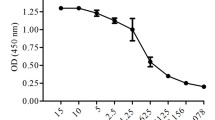Abstract
Attempts to improve the selectivity of anti-cancer agents by conjugating them to antibodies directed at tumour associated antigens have demonstrated tumour localisation but only limited therapeutic success. We report here the advantage of a 2-stage approach in which the first component combines the selective delivery of antibody with a capability to generate a cytotoxic agent from a second subsequently administered component. A bacterial enzyme, carboxypeptidase G2 (CPG2) was conjugated with F(ab')2 fragment of a monoclonal antibody directed at beta subunit of human chorionic gonadotrophin (beta-hCG) and injected into nude mice bearing hCG producing CC3 xenografts of human choriocarcinoma. Time was allowed for the conjugate to localise at tumour sites and clear from blood before injecting para-N-bis (2-chloroethyl) aminobenzoylglutamic acid. Cleavage of the glutamic acid moiety from this molecule by CPG2 released a benzoic acid mustard. Growth of the tumour which is resistant to conventional chemotherapy was markedly depressed by a single course of treatment. This demonstrates for the first time the potential of an antibody directed enzyme to activate an alkylating agent and to eradicate an established human cancer xenograft.
Similar content being viewed by others
Author information
Authors and Affiliations
Rights and permissions
About this article
Cite this article
Bagshawe, K., Springer, C., Searle, F. et al. A cytotoxic agent can be generated selectively at cancer sites. Br J Cancer 58, 700–703 (1988). https://doi.org/10.1038/bjc.1988.293
Issue Date:
DOI: https://doi.org/10.1038/bjc.1988.293
- Springer Nature Limited
This article is cited by
-
A 12-Crown-4 Ether Containing Dipeptide Boc-12-Crown-4-l-DOPA-Gly-OMe Induces Cell Cycle Arrest and Apoptosis in Rat Eggs Cultured In Vitro
International Journal of Peptide Research and Therapeutics (2016)
-
Functional Overexpression and Purification of a Codon Optimized Synthetic Glucarpidase (Carboxypeptidase G2) in Escherichia coli
The Protein Journal (2009)
-
Novel approaches on prodrug based drug design
Pharmaceutical Chemistry Journal (2008)
-
Novel antibodies as anticancer agents
Oncogene (2007)
-
Effect of pH and human serum albumin on the cytotoxicity of a glucuronide prodrug of 9-aminocamptothecin
Cancer Chemotherapy and Pharmacology (2007)




